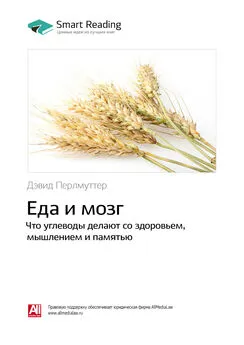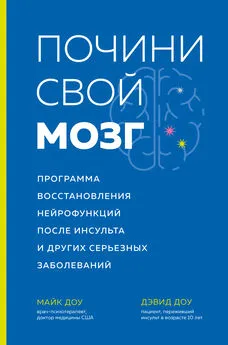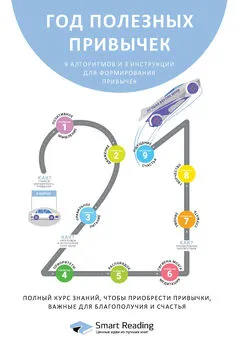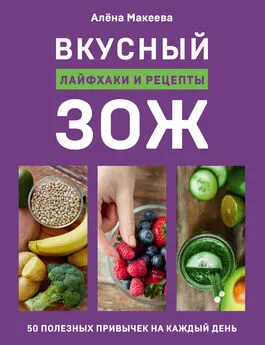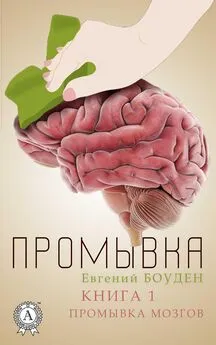Дэвид Перлмуттер - Промывка мозга. Программа для ясного мышления, укрепления отношений с людьми и развития полезных привычек
- Название:Промывка мозга. Программа для ясного мышления, укрепления отношений с людьми и развития полезных привычек
- Автор:
- Жанр:
- Издательство:Литагент МИФ без подписки
- Год:2020
- Город:Москва
- ISBN:978-5-00169-168-6
- Рейтинг:
- Избранное:Добавить в избранное
-
Отзывы:
-
Ваша оценка:
Дэвид Перлмуттер - Промывка мозга. Программа для ясного мышления, укрепления отношений с людьми и развития полезных привычек краткое содержание
На русском языке публикуется впервые.
Промывка мозга. Программа для ясного мышления, укрепления отношений с людьми и развития полезных привычек - читать онлайн бесплатно ознакомительный отрывок
Интервал:
Закладка:
G. Kim et al. “Functional Neuroanatomy Associated with Natural and Urban Scenic Views in the Human Brain: 3.0T Functional MR Imaging,” Korean J. Radiol. 11, № 5 (September – October 2010): 507–513.
175
Y. T. Uhls et al. “Five Days at Outdoor Education Camp Without Screens Improves Preteen Skills with Nonverbal Emotion Cues,” Comput. Human Behav. 39 (October 2014): 387–392.
176
T. Baumgartner et al. “Frequency of Everyday Pro-Environmental Behaviour Is Explained by Baseline Activation in Lateral Prefrontal Cortex,” Sci. Rep. 9, № 9 (January 2019).
177
G. X. Mao et al. “Effects of Short-Term Forest Bathing on Human Health in a Broad-Leaved Evergreen Forest in Zhejiang Province, China,” Biomed. Environ. Sci. 25, № 3 (June 2012): 317–324.
178
R. A. Atchley, D. L. Strayer, and P. Atchley. “Creativity in the Wild: Improving Creative Reasoning Through Immersion in Natural Settings,” PLoS One 7, № 12 (December 2012): e51474.
179
R. Mitchell and F. Popham. “Effect of Exposure to Natural Environment on Health Inequalities: An Observational Population Study,” Lancet 372, № 9650 (November 2008): 1655–1660.
180
D. L. Crouse et al. “Urban Greenness and Mortality in Canada’s Largest Cities: A National Cohort Study,” Lancet Planet. Health 1, № 7 (October 2017): e289–97.
181
D. Vienneau et al. “More Than Clean Air and Tranquillity: Residential Green Is Independently Associated with Decreasing Mortality,” Environ. Int. 108 (November 2017): 176–184.
182
M. van den Berg et al. “Health Benefits of Green Spaces in the Living Environment: A Systematic Review of Epidemiological Studies,” Urban For. Urban Green. 14, № 4 (August 2015): 806–816.
183
R. H. Lustig. “Processed Food – An Experiment That Failed,” JAMA Pediatr. 171, № 3 (March 2017): 212–214.
184
L. Schnabel et al. “Association Between Ultraprocessed Food Consumption and Risk of Mortality Among Middle-Aged Adults in France,” JAMA Intern. Med. 179, № 4 (February 2019): 490–498.
185
Ультраобработанные продукты и напитки содержат стабилизаторы, ароматизаторы, эмульгаторы и прочие добавки и готовы к употреблению при покупке или после разогревания: газированные напитки, готовая пицца, выпечка, хот-доги, готовые супы, «фруктовые» йогурты, растворимая лапша и так далее. Прим. пер.
186
GBD 2017 Diet Collaborators. “Health Effects of Dietary Risks in 195 Countries, 1990–2017: A Systematic Analysis for the Global Burden of Disease Study 2017,” Lancet 393, № 10184 (May 2019): 1958–1972.
187
По опубликованным данным, с кукурузным сиропом средний американец получает до половины съедаемого сахара. Прим. ред.
188
US Department of Health and Human Services, “What Is a Food Additive?” https://www.hhs.gov/answers/public-health-and-safety/what-is-a-food-additive/index.html.
189
US Food and Drug Administration. “Overview of Food Ingredients, Additives & Colors”. https://www.fda.gov/food/food-ingredients-packaging/overview-food-ingredients-additives-colors.
190
US Food and Drug Administration. “Overview of Food Ingredients.”
191
B. Popkin and C. Hawkes. “The Sweetening of the Global Diet, Particularly Beverages: Patterns, Trends and Policy Responses for Diabetes Prevention,” Lancet Diabetes Endocrinol. 4, № 2 (February 2016): 174–186.
192
В различных сетевых ресторанах быстрого питания в России, принадлежащих мировым брендам, порция сладкой газировки составляет 0,3–0,8 литра. Объемы напитков в США схожи. Прим. ред.
193
V. S. Malik et al. “Long-Term Consumption of Sugar-Sweetened and Artificially Sweetened Beverages and Risk of Mortality in US Adults,” Circulation 139, № 18 (April 2019): 2113–2125.
194
A. Mummert et al. “Stature and Robusticity During the Agricultural Transition: Evidence from the Bioarchaeological Record,” Econ. Hum. Biol. 9, № 3 (July 2011): 284–301.
195
Jared Diamond “The Worst Mistake in the History of the Human Race,” Discover, May 1987. (См. также статью на русском языке: http://transmission.lenin.ru/Diamond-Mistake.html).
196
Diamond. “The Worst Mistake.”
197
Харари Ю. Sapiens. Краткая история человечества. – М.: Синдбад, 2016. Прим. ред.
198
Yuval Noah Harari. Sapiens: A Brief History of Humankind (New York: Harper, 2015).
199
J. Graham Ruby et al. “Estimates of the Heritability of Human Longevity Are Substantially Inflated Due to Assortative Mating,” Genetics 210, № 3 (November 1, 2018): 1109–1124.
200
F. N. Jacka et al. “Western Diet Is Associated with a Smaller Hippocampus: A Longitudinal Investigation,” BMC Med. 13 (September 2015): 215; см. также T. Akbaraly et al. “Association of Long-Term Diet Quality with Hippocampal Volume: Longitudinal Cohort Study,” Am. J. Med. 131, № 11 (November 2018): 1372–1381.
201
A. Ramirez et al. “Elevated HbA1c Is Associated with Increased Risk of Incident Dementia in Primary Care Patients,” J. Alzheimers Dis. 44, № 4 (2015): 1203–1212.
202
Lustig. “Processed Food.”
203
Y. Lee et al. “Cost-Effectiveness of Financial Incentives for Improving Diet and Health through Medicare and Medicaid: A Microsimulation Study,” PLoS Med. 16, № 3 (March 2019): e1002761.
204
M. K. Potvin and A. Wanless. “The Influence of the Children’s Food and Beverage Advertising Initiative: Change in Children’s Exposure to Food Advertising on Television in Canada between 2006–2009,” Int. J. Obes. (Lond.) 38, № 4 (April 2014): 558–562.
205
S. Rinc о n-Gallardo Patiño et al. “Nutritional Quality of Foods and Non-Alcoholic Beverages Advertised on Mexican Television According to Three Nutrient Profile Models,” BMC Public Health 16 (August 2016): 733.
206
M. M. Romero-Fernández, M. Á. Royo-Bordonada, and F. Rodríguez-Artalejo. “Evaluation of Food and Beverage Television Advertising During Children’s Viewing Time in Spain Using the UK Nutrient Profile Model,” Public Health Nutr. 16, № 7 (July 2013): 1314–1320.
207
M. Hajizadehoghaz, M. Amini, and A. Abdollahi. “Iranian Television Advertisement and Children’s Food Preferences,” Int. J. Prev. Med. 7 (December 2016): 128.
208
J. L. Harris, J. A. Bargh, and K. D. Brownell. “Priming Effects of Television Food Advertising on Eating Behavior,” Health Psychol. 28, № 4 (July 2009): 404–413.
209
E. J. Boyland et al. “Food Choice and Overconsumption: Effect of a Premium Sports Celebrity Endorser,” J. Pediatr. 163, № 2 (August 2013): 339–343.
210
J. A. Emond et al. “Exposure to Child-Directed TV Advertising and Preschoolers’ Intake of Advertised Cereals,” Am. J. Prev. Med. 56, № 2 (2019): e35-e43.
211
M. A. Bragg et al. “Sports Sponsorships of Food and Nonalcoholic Beverages,” Pediatrics 141, № 4 (April 2018): e20172822.
212
S. Luo et al. “Abdominal Fat Is Associated with a Greater Brain Reward Response to High-Calorie Food Cues in Hispanic Women,” Obesity (Silver Spring) 21, № 10 (October 2013): 2029–2036.
213
Таубс Г. Почему мы толстеем. Мифы и факты о том, что мешает нам быть стройными. – М.: Эксмо, 2014. Прим. пер.
214
Y. Yang et al. “Executive Function Performance in Obesity and Overweight Individuals: A Meta-Analysis and Review,” Neurosci. Biobehav. Rev. 84 (January 2018): 225–244.
215
N. Mac Giollabhui et al. “Executive Dysfunction in Depression in Adolescence: The Role of Inflammation and Higher Body Mass,” Psychol. Med (March 2019): 1–9.
216
Giollabhui et al. “Executive Dysfunction.”
217
J. A. Bremser and G. G. Gallup. “Mental State Attribution and Body Configuration in Women,” Front. Evol. Neurosci. 4 (January 2012): 1.
218
B. S. Lennerz et al. “Effects of Dietary Glycemic Index on Brain Regions Related to Reward and Craving in Men,” Am. J. Clin. Nutr. 98, № 3 (September 2013): 641–647.
219
R. Chen et al. “Decision Making Deficits in Relation to Food Cues Influence Obesity: A Triadic Neural Model of Problematic Eating,” Front. Psychiatry 9 (June 2018): 264.
220
M. T. Osborne et al. “Amygdalar Activity Predicts Future Incident Diabetes Independently of Adiposity,” Psychoneuroendocrinology 100 (February 2019): 32–40.
221
S. C. Staubo et al. “Mediterranean Diet, Micro-and Macronutrients, and MRI Measures of Cortical Thickness,” Alzheimers Dement. 13, № 2 (February 2017): 168–177.
222
A. Molfino et al. “The Role for Dietary Omega-3 Fatty Acids Supplementation in Older Adults,” Nutrients 6, № 10 (October 2014): 4058–4072.
223
R. K. McNamara et al. “Docosahexaenoic Acid Supplementation Increases Prefrontal Cortex Activation During Sustained Attention in Healthy Boys: A Placebo-Controlled, Dose-Ranging, Functional Magnetic Resonance Imaging Study,” Am. J. Clin. Nutr. 91, № 4 (April 2010): 1060–1067; см. также S. C. Dyall, “Long-Chain Omega-3 Fatty Acids and the Brain: A Review of the Independent and Shared Effects of EPA, DPA, and DHA,” Front. Aging Neurosci. 7 (April 2015): 52.
224
Перлмуттер Д., Лоберг К. Кишечник и мозг: Как кишечные бактерии исцеляют и защищают ваш мозг. – М.: Манн, Иванов и Фербер, 2016. Прим. пер.
225
David Perlmutter. Brain Maker: The Power of Gut Microbes to Heal and Protect Your Brain for Life (New York: Little, Brown, 2015). См. также издание на русском языке: Перлмуттер Д., Лоберг К. Кишечник и мозг. Как кишечные бактерии исцеляют и защищают ваш мозг. – М.: Манн, Иванов и Фербер, 2016.
Читать дальшеИнтервал:
Закладка:
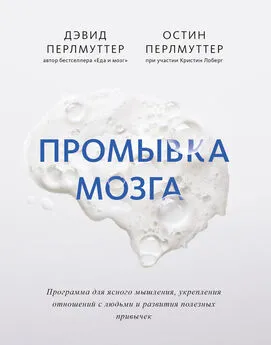



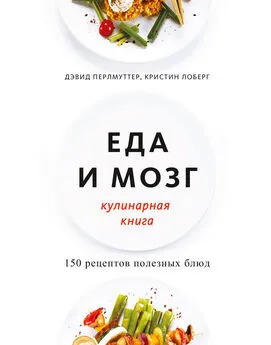
![Дэвид Доу - Почини свой мозг. Программа восстановления нейрофункций после инсульта и других серьезных заболеваний [litres]](/books/1143582/devid-dou-pochini-svoj-mozg-programma-vosstanovlen.webp)
